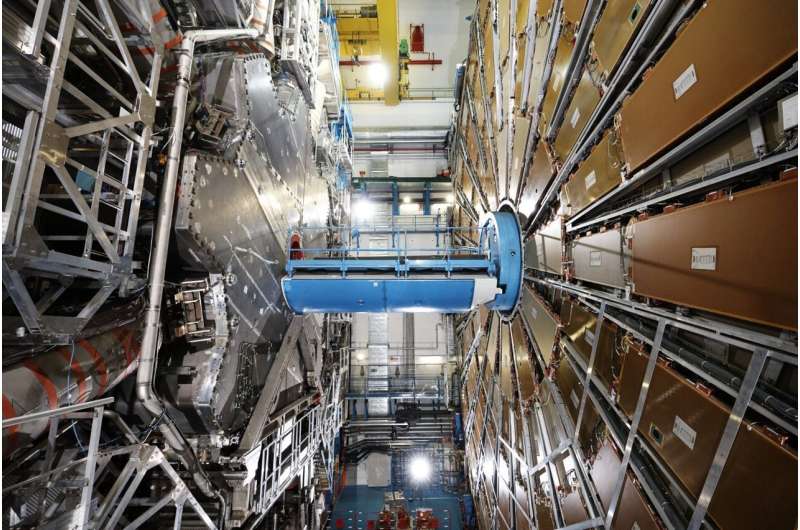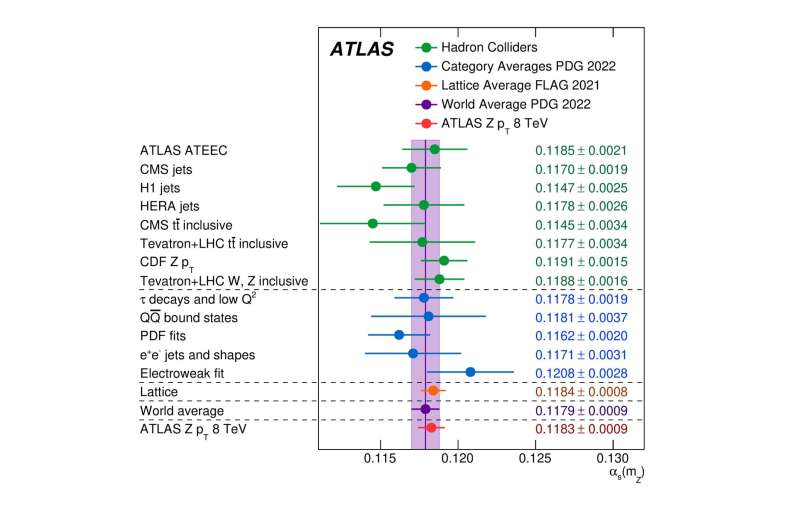This article has been reviewed according to Science X's editorial process and policies. Editors have highlighted the following attributes while ensuring the content's credibility:
fact-checked
peer-reviewed publication
trusted source
proofread
ATLAS measures strength of the strong force with record precision

Binding together quarks into protons, neutrons and atomic nuclei is a force so strong, it's in the name. The strong force, which is carried by gluon particles, is the strongest of all fundamental forces of nature—the others being electromagnetism, the weak force and gravity. Yet, it's the least precisely measured of these four forces.
In a paper just submitted to Nature Physics and currently available on the arXiv preprint server, the ATLAS collaboration describes how it has used the Z boson, the electrically neutral carrier of the weak force, to determine the strength of the strong force with an unprecedented uncertainty of below 1%.
The strength of the strong force is described by a fundamental parameter in the Standard Model of particle physics called the strong coupling constant. While knowledge of the strong coupling constant has improved with measurements and theoretical developments made over the years, the uncertainty on its value remains orders of magnitude larger than that of the coupling constants for the other fundamental forces.
A more precise measurement of the strong coupling constant is required to improve the precision of theoretical calculations of particle processes that involve the strong force. It is also needed to address important unanswered questions about nature. Could all of the fundamental forces be of equal strength at very high energy, indicating a potential common origin? Could new, unknown interactions be modifying the strong force in certain processes or at certain energies?
In its new study of the strong coupling constant, the ATLAS collaboration investigated Z bosons produced in proton–proton collisions at CERN's Large Hadron Collider (LHC) at a collision energy of 8 TeV. Z bosons are typically produced when two quarks in the colliding protons annihilate. In this weak-interaction process, the strong force comes into play through the radiation of gluons off the annihilating quarks.
This radiation gives the Z boson a "kick" transverse to the collision axis (transverse momentum). The magnitude of this kick depends on the strong coupling constant. A precise measurement of the distribution of Z-boson transverse momenta and a comparison with equally precise theoretical calculations of this distribution allows the strong coupling constant to be determined.
In the new analysis, the ATLAS team focused on cleanly selected Z-boson decays to two leptons (electrons or muons) and measured the Z-boson transverse momentum via its decay products. A comparison of these measurements with theoretical predictions enabled the researchers to precisely determine the strong coupling constant at the Z-boson mass scale to be 0.1183 ± 0.0009.
With a relative uncertainty of only 0.8%, the result is the most precise determination of the strength of the strong force made by a single experiment to date. It agrees with the current world average of experimental determinations and state-of-the-art calculations known as lattice quantum chromodynamics (see figure below).

This record precision was accomplished thanks to both experimental and theoretical advances. On the experimental side, the ATLAS physicists achieved a detailed understanding of the detection efficiency and momentum calibration of the two electrons or muons originating from the Z-boson decay, which resulted in momentum precisions ranging from 0.1% to 1%.
On the theoretical side, the ATLAS researchers used, among other ingredients, cutting-edge calculations of the Z-boson production process that consider up to four "loops" in quantum chromodynamics. These loops represent the complexity of the calculation in terms of contributing processes. Adding more loops increases the precision.
"The strength of the strong nuclear force is a key parameter of the Standard Model, yet it is only known with percent-level precision. For comparison, the electromagnetic force, which is 15 times weaker than the strong force at the energy probed by the LHC, is known with a precision better than one part in a billion," says CERN physicist Stefano Camarda, a member of the analysis team.
"That we have now measured the strong force coupling strength at the 0.8% precision level is a spectacular achievement. It showcases the power of the LHC and the ATLAS experiment to push the precision frontier and enhance our understanding of nature."
More information: A precise determination of the strong-coupling constant from the recoil of Z bosons with the ATLAS experiment at √s = 8 TeV, arXiv (2023). DOI: 10.48550/arxiv.2309.12986
Journal information: Nature Physics , arXiv
Provided by CERN





















